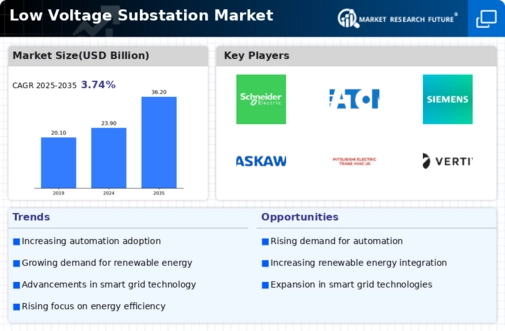Urbanization and Population Growth
Urbanization and population growth are driving factors in the Low Voltage Substation Market. As urban areas expand, the demand for reliable and efficient power distribution systems increases. This necessitates the development of low voltage substations to support the growing energy needs of densely populated regions. The trend of urbanization is expected to continue, with projections indicating that by 2050, nearly 68 percent of the world's population will reside in urban areas. This demographic shift will likely lead to increased investments in low voltage substations, as utilities seek to enhance their infrastructure to meet the rising demand for electricity in urban centers.
Rising Demand for Energy Efficiency
The Low Voltage Substation Market is experiencing a notable increase in demand for energy-efficient solutions. As energy costs continue to rise, both consumers and businesses are seeking ways to reduce their energy consumption. This trend is further supported by government initiatives aimed at promoting energy efficiency. For instance, various countries have implemented regulations that encourage the adoption of low voltage substations, which are designed to optimize energy distribution and minimize losses. The market is projected to grow as more entities recognize the long-term cost savings associated with energy-efficient technologies. In fact, the energy efficiency market is expected to reach substantial figures, indicating a robust growth trajectory for the Low Voltage Substation Market.
Increased Focus on Renewable Energy Sources
The Low Voltage Substation Market is significantly influenced by the growing emphasis on renewable energy sources. As nations strive to meet sustainability goals, the integration of renewable energy into existing power grids becomes imperative. Low voltage substations facilitate this integration by providing the necessary infrastructure to connect renewable energy sources, such as solar and wind, to the grid. This trend is expected to accelerate as more countries commit to reducing carbon emissions and transitioning to cleaner energy solutions. The market for low voltage substations is projected to expand as utilities invest in upgrading their infrastructure to accommodate the influx of renewable energy, thereby enhancing the overall resilience of the energy system.
Government Initiatives and Regulatory Support
Government initiatives and regulatory support are pivotal in shaping the Low Voltage Substation Market. Many governments are implementing policies that promote the modernization of electrical infrastructure, including low voltage substations. These initiatives often include financial incentives, grants, and subsidies aimed at encouraging utilities to invest in advanced technologies and infrastructure upgrades. Such support not only facilitates the adoption of low voltage substations but also ensures compliance with evolving energy standards. As regulatory frameworks become more stringent, the market is likely to witness increased activity, with utilities striving to enhance their systems to meet both regulatory requirements and consumer expectations.
Technological Advancements in Substation Design
Technological advancements are playing a crucial role in shaping the Low Voltage Substation Market. Innovations such as digital substations and automated control systems are enhancing operational efficiency and reliability. These advancements allow for real-time monitoring and management of energy distribution, which is essential in today's fast-paced energy landscape. The integration of advanced technologies not only improves performance but also reduces maintenance costs, making low voltage substations more appealing to utility companies. As these technologies continue to evolve, they are likely to drive further investment in the Low Voltage Substation Market, fostering a competitive environment that encourages continuous improvement and innovation.


















Leave a Comment